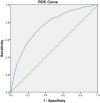Preoperative Red Cell Distribution Width and 30-day mortality in older patients undergoing non-cardiac surgery: a retrospective cohort observational study
- PMID: 29670189
- PMCID: PMC5906451
- DOI: 10.1038/s41598-018-24556-z
Preoperative Red Cell Distribution Width and 30-day mortality in older patients undergoing non-cardiac surgery: a retrospective cohort observational study
Abstract
Increased red cell distribution width (RDW) is associated with poorer outcomes in various patient populations. We investigated the association between preoperative RDW and anaemia on 30-day postoperative mortality among elderly patients undergoing non-cardiac surgery. Medical records of 24,579 patients aged 65 and older who underwent surgery under anaesthesia between 1 January 2012 and 31 October 2016 were retrospectively analysed. Patients who died within 30 days had higher median RDW (15.0%) than those who were alive (13.4%). Based on multivariate logistic regression, in our cohort of elderly patients undergoing non-cardiac surgery, moderate/severe preoperative anaemia (aOR 1.61, p = 0.04) and high preoperative RDW levels in the 3rd quartile (>13.4% and ≤14.3%) and 4th quartile (>14.3%) were significantly associated with increased odds of 30-day mortality - (aOR 2.12, p = 0.02) and (aOR 2.85, p = 0.001) respectively, after adjusting for the effects of transfusion, surgical severity, priority of surgery, and comorbidities. Patients with high RDW, defined as >15.7% (90th centile), and preoperative anaemia have higher odds of 30-day mortality compared to patients with anaemia and normal RDW. Thus, preoperative RDW independently increases risk of 30-day postoperative mortality, and future risk stratification strategies should include RDW as a factor.
Conflict of interest statement
The authors declare no competing interests.
Figures



References
Publication types
MeSH terms
Substances
Associated data
LinkOut - more resources
Full Text Sources
Other Literature Sources
Medical

